We were warmly greeted by Yulisse and Reggie Stoby and our dear Marie Lewis, just as soon as we ascended the snow-encrusted steps and rang the bell. Emma and I spent the greater part of one week with our friends in New York. It was really cold, and during the next day or two we had to re-adjust to winter conditions.
Before going over to California, we revisited one of our favourite haunts, the Radio City Music Hall, and took in a very nice show there.
We completed our journey back to Paradise, in California, in another couple of days taking a Continental Airlines non-stop flight to San Francisco, where we connected with a Hughes Air West for Chico airport after a wait of two to three hours. I phoned Gordon's house as soon as we arrived, and in a little while Arna and the two children, Lucia and Gordie came along for us. Gordon was on emergency duty at the Redding hospital that night, but came home by noon on the following day. Redding is just about two hours travel by freeway from Paradise. His home on Roe Road was built on a hilltop, and it was impossible to see it from the road. Surrounded by a stand of tall and stately pines with a liberal growth of indigenous manzanitas, it presented a truly rural picture. There was a lot of good garden land around the house, and several fruit trees were planted there. Among them were cherries, plums, pears, peaches, grapes and persimmons. Quite a few large walnut trees were on the land also, and there were two kitchen gardens with corn, tomatoes, strawberries, beans, lettuce, potatoes, and an assortment of useful vegetables as well.
When we got there, it was still. too cold to start the spring planting, but preparations were already in progress for this. Fences were being mended to keep out the deer, and the ground was being prepared for rotor-tilling in the near future.
On this hilltop too, lived Marie Hopkins, a widow, and dear friend of Gordon and family and it was arranged that Emma and I would live in her large home until such time as we could become a bit more sorted out and settled. The two houses, Gordon's and hers, were just a couple of hundred yards apart, and this was very convenient for us.
Because we were still at the tail end of winter, many of the trees were bare. The ground around the two homes was carpeted with pine needles, and there were literally hundreds of pine cones that had fallen. It was a delight to see the squirrels with their elegant bushy tails running up and down the trees and a walk through the woods behind the houses, which extended for at least a mile, was a veritable haven for nature lovers. Small wonder the place acquired its name - Paradise!
I was told that approximately thirty thousand people lived in this town built on a high ridge between Chico on the one side, and Oroville in a southerly direction on the other. The houses were so constructed that very often one had to look for them, hidden as they were between and behind majestic pines and other foliage which helped in preserving a rustic atmosphere so greatly preferred by the people, a large percentage of whom were retired folk and who really enjoyed the peace and quiet of this extremely restful setting. The area was smog-free, and there was a building boom going on most of the time we lived there. It took us about two months to really become organized before being able to set up house on our own.
I had to await the arrival of items like excess clothing, linen, and certain household things we had airfreighted from Guyana back to the U.S.A. and collect them from the Sacramento airport. Then we had to re-arrange our benefits to our new address, and go through a whole new reorientation for living. By an amazing stroke of good fortune, I was able to secure a lease on a low income apartment in Buschmann road, newly built for senior citizens. It was through the instrumentality and great help of Marion Hall, a social worker in Paradise, that this was possible, and we were very thankful for the great kindness shown us by this lady. At the end of April 1974, Emma and I moved into 1080 Buschmann Road, Apt.1, and once again, embarked upon a life of our own.
It was a small apartment of one bedroom, but quite modern and the work required to keep it tidy was minimal. It was air-conditioned, had adequate heating for winter, was equipped with Westinghouse electric range and refrigerator, and had picture windows all around. The locality was good, opposite to the Mormon Church, and just four hundred yards from a cute and well-kept park in the centre of which was a swimming pool. We were also near the supermarkets and shopping area, yet somewhat off the noisy highway traffic.
The complex in which our apartment was situated contained twenty-four units, and had its own recreation room and laundry facilities for the residents. It was just right for us at the time. Having settled down in our new home, we thought it was a good idea to visit some of the friends we had lived among for over seven years in southern California. So in June, 1974, we took off in our trusted Chevelle for Loma Linda, Colton and Riverside.
Our car was in good shape and we motored all the way, stopping at Sacramento first, and visited friends there. Then we continued south, by-passing Los Angeles, going through the Mojave desert and coming out into Sin Bernardino. It was pretty late in the evening when we checked into a really nice motel on 'E' street near to the Post Office.
Friends of ours and former neighbours in Reche Canyon, Clarence and Milly Eisenlord, had invited us to stay at their home and on the following morning we arrived at their place. We spent a lovely week at their large mobile home, playing a lot of Bridge, swimming in my favourite pool and visiting the many friends we had in this park.
I called on my former colleagues at Loma Linda Hospital Pharmacy, and everyone there was glad to see me again.
Before we left the area, we spent two days with Lloyd and Vilma Adams in Riverside, and took a bus ride from their place into Los Angeles, looking at some of the old familiar haunts. It was a very pleasant week which we climaxed with a dance at the Senior Citizens Centre in San Bernardino, before returning home to Paradise.
We motored back the same way, again avoiding the heavy traffic in Los Angeles, by selecting the desert route. Breaking our return trip in Sacramento where we spent the night, we got into Paradise by early afternoon on the following day. Shortly after our return home, Arna and some of her relatives asked us to join them on a tour of Shasta Lake and Caverns, a very scenic spot and tourist centre a little beyond Redding. This entailed a two-hour ride up-state, and we used two cars to accommodate everybody.
We reached Shasta Lake and began the tour with a colourful catamaran cruise across the lake. It was only a 15 minute ride on the sky-blue water, surrounded by majestic mountains. Then a specially equipped bus took us right up a mountainside about 800 feet above the lake surface. This winding drive to the entrance of the cave afforded an ever changing panorama of spectacular lake and mountain scenery, and the drive itself was quite thrilling. At the door of the cavern we were met by a trained and experienced guide, who gave us a conducted tour, describing the formation of stalactites and stalagmites, the multi-coloured fluted columns, and the sixty-foot high stone draperies in symmetrical folds studded with brilliant crystals.
This mountain cave presented a complete fairyland of nature's limestone creations. There were several "floors" in the cavern, and access to each was gained by flights of concrete stairs built, one of which had well over 100 steps.
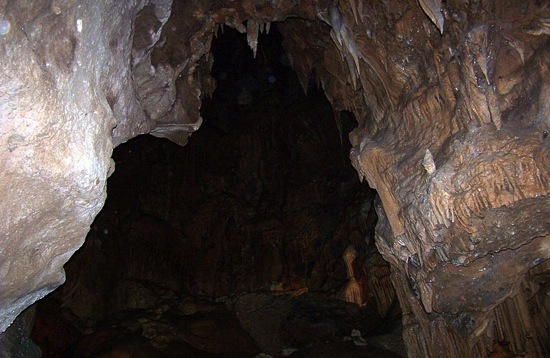 The other side had a sheer drop of many feet, but an iron rail was erected to ensure a measure of safety to visiting tourists.The last of the "floors" to which we were taken was called the "Cathedral" room and it consisted of a rather flat surface with a wall of fluted limestone which greatly resembled the pipes of a giant organ.
The other side had a sheer drop of many feet, but an iron rail was erected to ensure a measure of safety to visiting tourists.The last of the "floors" to which we were taken was called the "Cathedral" room and it consisted of a rather flat surface with a wall of fluted limestone which greatly resembled the pipes of a giant organ.The caverns remain just as nature made them, but certain conveniences such as paved walkway, stairs, guard rails, and indirect lighting have been added. There is no moisture condition requiring protective clothing or footwear, and the temperature is a comfortable 58 degrees F. constantly.
There were several arms of Lake Shasta, and during many months of the year it is a popular resort and marina. One can hire houseboats of various types and really enjoy a wonderful holiday here, taking the whole family along. This was indeed a delightful trip, and I took a number of photographs before we left for home.
Later that summer, in July, Emma and I decided to visit Expo '74 which was being held in Spokane, in the Pacific state of Washington, and which is just below the Canadian border.
I had the Chevelle checked over for one of the longest rides I would be taking and we motored up to some friends, Jackie and Bill Peters, who lived at Moses Lake, Washington. To make the journey easy, I decided to take two days doing it, and I chose the city of Bend in central Oregon as our overnight stop. Some of the beauty spots passed were Klamath falls and lake, and Mount Shasta. The drive was very pleasant and uneventful, and towards late afternoon we reached Bend where I found a suitable motel in which we stayed for the night. Continuing next morning, we reached the south side of the Columbia river, amidst some of the most gorgeous mountain scenery on the Oregon side. This river marks the boundary between Oregon and Washington.
Following an easterly course along the river - the highway was built along the side of it - the view was outstanding. I took the curve which carried us into Washington State near the town of Pasco, and reached Bill and Jackie's place in the afternoon. They were quite happy for us to stay there as long as we liked, and agreed to go along with us to Expo '74 in Spokane in another couple of days. Their son, Stephen was with his grandparents in Canada so there was plenty of room for us. Our company was very welcome to them too since Moses Lake was a rather lonely spot. The country around their large mobile home consisted of wide tracts of farmland on which was grown acres of wheat, alfalfa and beets. It was my privilege to see how a wheat combine
reaps, threshes, winnows and transfers the finished product into a waiting truck with a single operator in his glass-enclosed, air-conditioned cab, listening to stereo music on tapes while he worked.
Expo '74 proved to be just a glamorised country fair. We all enjoyed the American and Russian pavilions, and partook of a really special dinner at the latter place. It was well after midnight when we got home, very tired since a lot of walking was involved at the exposition grounds.
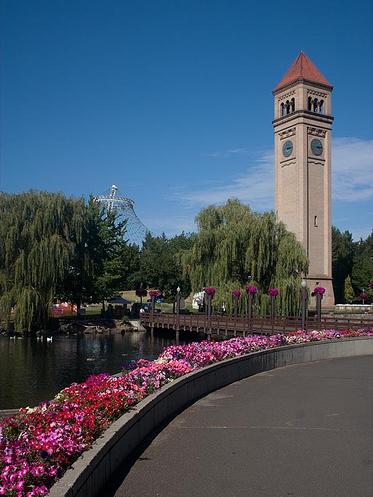
The next day, however, we made a splendid trip to the Grand Coulee Dam, one of America's great hydro-electric power complexes situated on the Columbia River in central Washington. This great dam produces millions of kilowatts of electrical power, and has greatly benefited the farming industry in the Columbia Basin, where the land, previous to its erection, was nothing but parched though extremely fertile desert, wasting away for lack of water. I was reliably told that since the Grand Coulee Dam was built, the value of the agricultural produce in the region now exceeds a total of one hundred million dollars.
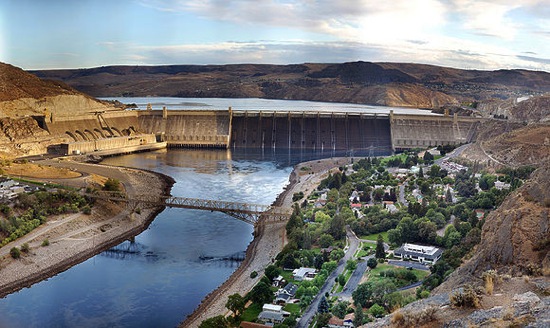
Our party joined a conducted tour, and was shown over a lot of the works there, which included a stroll along the top of the giant spillway where the water was a great frothy churn of snow-white foam as it cascaded below. On our way back to Jackie's home we stopped at Dry Falls, which can really be described as the skeleton of one of the greatest waterfalls in geologic history. It is three and a half miles wide, with a drop of over four hundred feet. This prehistoric waterfall was forty times mightier than Niagara.
It was explained to me that millions of years ago, during the glacial period, the mighty Columbia River was diverted from its original course due to earth pressures in the ice age. As the glaciers receded at some later date carrying away softer strata of the earth's crust, Dry Falls remained, and it now bears silent witness to the tremendous forces of nature.
We returned to Moses Lake and left for Paradise in another couple of days. I varied our return trip a little by avoiding the curve of the river near the Oregon border, going over a toll-bridge instead, and continuing the delightful scenic drive to Biggs along the water's edge, where we turned south. Again I broke the journey in Bend, Oregon, spent the night there, and arrived home in Paradise late the following afternoon. The trip was a good test of my ability to stand up to nine hours of continuous high speed driving on the freeways from central Oregon to Paradise, California.
Our son Gordon, who had been living in Paradise for the last four years, now decided to move to Georgia, three thousand miles away on the Atlantic coast. He sold his property and packed his household things into a large moving van, then drove it and his family all the way across country to the new home of his choice in Wildwood, Georgia. In retrospect, I cannot help thinking that there must be a certain measure of wanderlust in our family - the removal took him about four days.
Once more Emma and I are thousands of miles away from our nearest relative, but by now, we were becoming quite used to the idea. It was, however, quite a different feeling, having just a few friends around, instead of one's own kith and kin.
Towards the latter part of 1974, I developed a herniated lumbar disc and had to be hospitalized at the Feather River Hospital for five days. I was given traction, hot pack's, and whirlpool bath treatments, and after I was discharged, I got a friend of ours to build a rig onto my bed, so that I could continue the traction treatment at home.
Winter was now fast setting in, and we discovered that northern California was far colder than the south in which we had always lived. For a couple of days we were almost snow bound, with sixteen inches of snow all around our apartment, enveloping the car, and making life quite awkward. During this snowfall, some large trees fell across power lines cutting off electric supply to Paradise, so we were without cooking facilities and light for over a day.
Arising out of this, we had to clear out our refrigerator and freezer, and store our meat, chicken, milk and all perishables in the deep snow which had piled up nearly two feet high on the outside walls of our apartment. It was quite a new experience. Fortunately, the house was heated by gas, and so was our water supply. Were we all-electric, it would certainly have been very uncomfortable for us all.
It would have been quite possible to live in this quiet town if Gordon and his family had not gone, but the older we get, the more we realized the importance of man's gregariousness, especially in respect of his own family. We therefore decided it would be in our interest to leave Paradise. After a little enquiry and search, we chose a neat little apartment in North Highlands, a suburb of Sacramento, the capital city of California. Not only did we have more friends here than in Paradise, but there was a whole lot more to interest us than we ever had in all the seven years we lived in this state.
We moved our own furniture down the hundred miles with the kind help of two friends, using the popular "U-Haul" method. Shortly after we joined the Senior Citizen's centre and club, which provided us with all the companionship, entertainment, and cheap trips around the countryside that we could absorb. We were also quite close to all major communication lines, just in case we needed to make use of them. This removal to North Highlands was in March 1975, with both Emma and myself in reasonably good health.
After settling down in our new location, places in Sacramento like Sutter's Fort, The Capitol Park and Mall, and the Senate building were all visited by us, and we were later able to explore the Bay Area Rapid Transport (BART) system which is the local and very modern counterpart of the London Underground system. We took a long ride on "BART" one day, going under the San Francisco bay from the downtown area reaching out as far as Concord on the other side of the bay where the line ends.
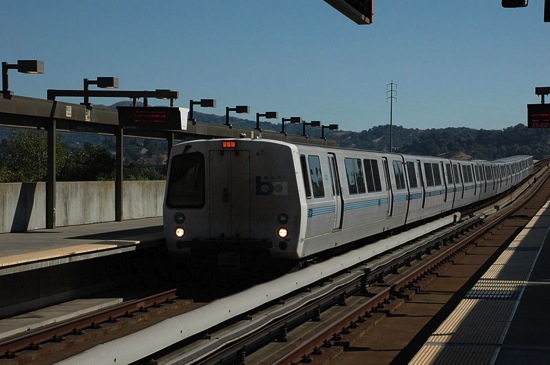
On yet another occasion we visited the Golden Gate Park, and what a delightful place this proved to be. We visited the Japanese Tea Gardens there, the De Yonge Museum and the fantastic Aquarium in the Natural Science Building. That was as much as we could absorb in one visit, so we returned another day and we were fortunate in being able to see an "Exhibition of Archaeological Finds of the Peoples Republic of China".
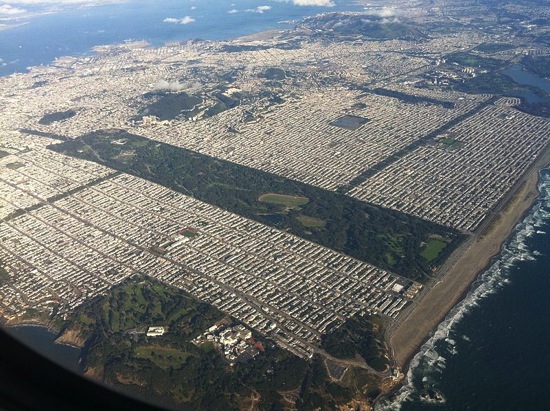
In this exhibition, three hundred and eighty-five works of art were displayed, embracing a time-span from the Palaeolithic age (about 600,000 years ago) through to the 14th century A.D. Included were prehistoric artefacts, ceramics, bronze vessels, oracle bones, stone sculpture, wood carvings and gold and silver utensils. They were fully dated and documented, and provided important and accurate comparative data.
During the summer of this year, (1975) one of the senior citizens groups to which we belonged, staged a one week outing on a Greyhound bus, involving a tour which took us from Sacramento through Yosemite Park where we stopped for lunch in the shadow of El Capitan.
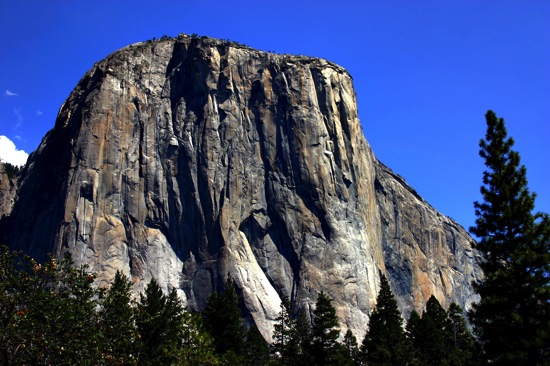
El Captain is a tremendous granite monolith which rises 3,000 feet above the valley floor, and it seems to salute the visitor as he approaches. It is reputed to be the largest single block of granite in the world, and much greater in volume than the Rock of Gibraltar.

We were housed in little log cabins, and spent that night in this setting of high forested country withsome of the most glorious rock formations we had ever seen. All the next day we were sightseeing in this area, and we slept there yet another night.
On the following morning, we rode our chartered Greyhound along the freeway on to the North Rim of the Grand Canyon. We spent a day and a night there, and witnessed some more of nature's marvellous rock sculpture and views that simply were indescribable.
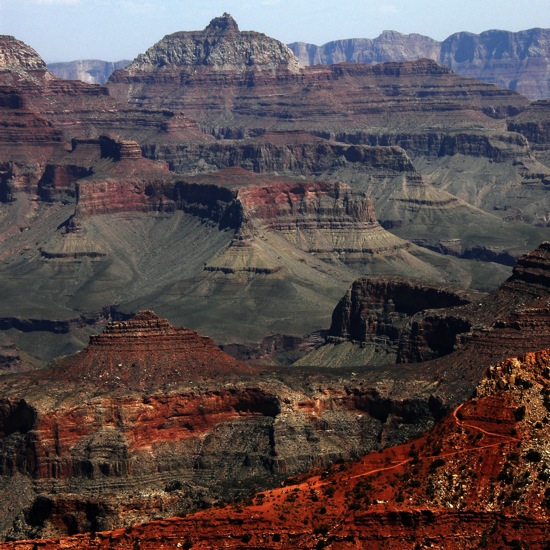
The Grand Canyon is in the state of Arizona, and on the following morning we returned to Utah and spent our fifth night at "Zion" National Park. Here we were once again put up in log cabins. We arrived at Zion in the early afternoon, and so were able to go sight-seeing for the rest of the day.
Our sixth day was spent travelling back through Nevada state, and we arrived at Las Vegas in the early afternoon. There we put up at the "Kings Inn" and during that evening we were taken on a conducted bus tour of the famous "Las Vegas Strip", by our experienced bus driver, who provided a running commentary over the speaker system of all we passed by. At night, Las Vegas, often described as the gambling capital of the world, is a sea of thousands, no millions of brilliant lights along its famous strip, and it was truly an education to see the way of life of one segment of people.
After spending the night (our last) in this exotic city, we left the following morning for Sacramento and home, via Reno, a famous divorce centre, passing through Hawthorne, Where we were pointed out the several bunkers containing explosives for the military, and which was spread over a very wide area. We arrived home that evening just before midnight after a very educational and pleasant week spent amidst some of the grandest sights one can ever hope to see in all of the North American continent.
To provide a little "in-depth" information about the National Parks, the first one we stayed at, Bryce National Canyon Park, is located in South-eastern Utah, about thirty miles north of the Arizona border. Here, sand, wind and water have carved the plateau into several horseshoe shaped amphitheatres, cutting limestone cliffs into fantastic forms, and exposing layers of rock that glow in delicate and varied colours, ranging from pinks to reds, in several shades, under a canopy of pure blue sky.
The natural structures, ranging from man-size to hundreds of feet in height, are identified by fanciful names like "Queen Victoria", "Tower Bridge", Mormon Temple" etc. A paved highway runs along the edge of the forested plateau, and several "overlooks" provide magnificent views to visitors. Miles of horse and pony trails depend easily from the plateau, and thread through the rock formations. The origin of these picturesque formations goes back thirteen to sixty million years. Erosion of the rim is steadily proceeding at the rate of twelve inches every fifty years.
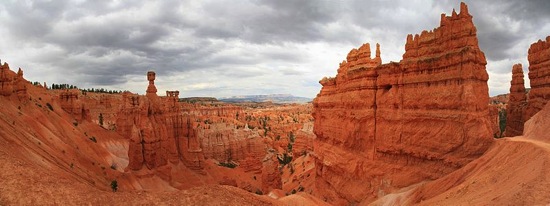
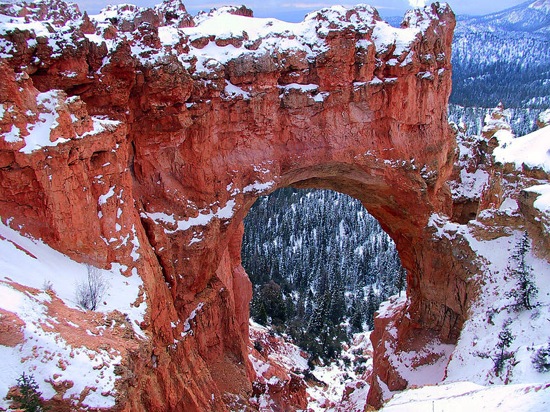
Bryce Canyon became a National Monument in 1923 and a National Park in 1928. It has an area of 56 square miles.
Looking down into the canyon, the surface seems to break off almost perpendicularly to a depth of several hundred feet. It appears as if the bottom had dropped out and left rocks standing in all shapes and forms as lone sentinels over a grotesque and picturesque scene…. There are thousands of red, white, purple and vermilion coloured rocks of all sizes resembling soldiers on the walls of castles, monks and priests in their robes, cathedrals and congregations, presenting the wildest and most wonderful scenes ever to behold.
Bryce Canyon was named after a Mormon settler, Ebenezer Bryce, who built his cabin on a tributary that drained one of the large amphitheatres, around the year 1874. He grazed cattle here for a shor time, but long enough to give a very vivid description of the place, " A hell ova place to lose a cow", and a name for the park.
Some of the most spectacular views may be seen from "Sunset Point"', "Inspiration Point", "Bryce Point", and Paria View". These vistas provide the most scenic concentration of sculptured red rocks in this area.
Zion Canyon National Park is located in south western Utah, and has an area of 147.000 acres. It was established as a park in 1919. Its walls are crowned with white pinnacles that shade almost imperceptibly to vermilion yellow below. Impressive heights include "The Great White Throne", (6,700 ft.) "The Beehives"", "The Sentinel" and the "Three Patriarchs". Access to Zion park is via the highway running from St. George. This park is a region of deep narrow canyons with vertical walls and massive rocky domes and pinnacles of gorgeous colours, mostly in varying tones of red. Zion canyon is nearly half a mile deep and is cut by the Virgin river which falls from 50 to 70 feet in a one mile stretch. Along the road leading to the lodge, there is a mile long Zion - Mount Carmel tunnel with open galleries which provide sweeping views of the canyon.
Zion Canyon was discovered in 1858 and the region was settled by Mormons, in 1861, who arrived from the Great Salt Lake Valley and gave it the name Zion. The great difference between "Bryce" and "Zion" is that whereas one looks down into Bryce, at Zion, you have to look way up, - heavenwards.
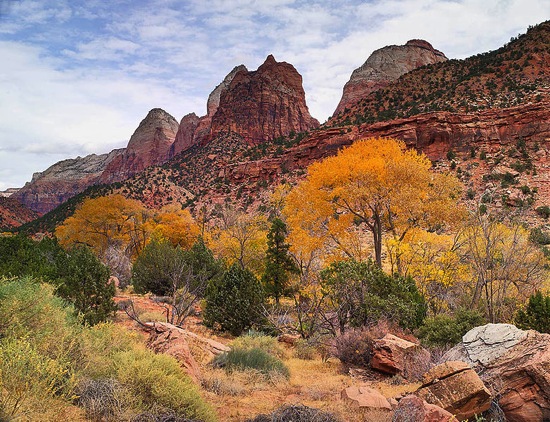
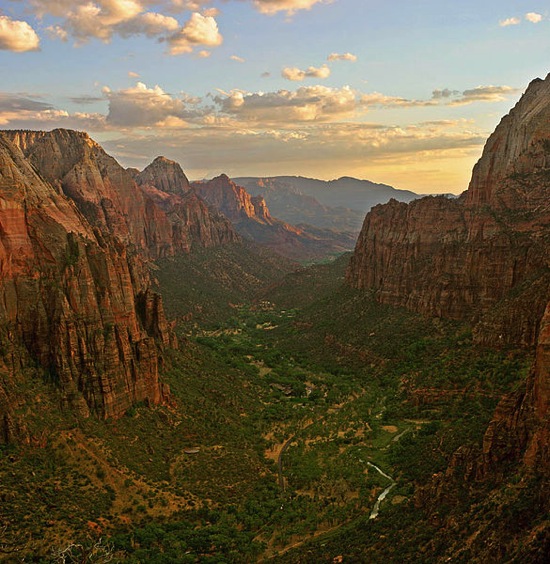
The North Rim of the Grand Canyon, however, was the most awe-inspiring and majestic of the three national parks we stayed at. Here, as at Bryce Canyon, you looked down into the views spread out before you, and here is a brief description I put together, obtained from leaflets and library research. The Grand Canyon is 277 miles long. Its width is more difficult to measure, the average distance from rim to rim is about ten miles. It is about one mile deep, 4460 feet from Bright Angel lodge on the south rim down to the river, (Colorado) and 5750 feet down from the Grand Canyon lodge (where we slept) on the North Rim.
The great pyramids of Egypt and the largest sky-scrapers of the 20th century would be equally lost within its depths.
In essence, the Grand Canyon of the Colorado is a canyon composed of many canyons. It is a composite of tens of thousands of gorges. In like manner, each wall of the Canyon is a composite structure, a wall composed of many walls, but never a repetition. Each one of these innumerable gorges is a world of beauty in itself. And all of these unite to form one Grand Canyon…. and what a sublime spectacle.... Geologists claim that the Grand Canyon began to form sometime in the last six million years.
Down in the inner gorge is the Colorado river, busily at work, doing its best to carry the mountains to the sea. It has cut the canyon to its present depth, but its work is not finished, it still has another 2400 feet to go before it is stopped at sea level. It has functioned like a giant conveyor belt, taking the weathered rock materials from as far away as the Rocky 'Mountains down to the Gulf of California. In cutting the canyon, the river has exposed the pages of geological history, and now lies, as a bookmark in time, to show us where to begin….
Going along with groups from the Senior Citizen's Center and the "Go-Goers" club, to which we belonged we made frequent trips by bus to Lake Tahoe, and areas like Donner Lake, Reno, and the Truckee river. To get there one has to go up and over the High Sierras where the air is pure and invigorating. The altitude is approximately 7,200 feet at the summit of the Sierras where the freeway winds its way over the top.
We spent our first Xmas in Sacramento very quietly, attending the Senior Citizens' Holiday dinner on December 20th, 1975, held at their spacious clubhouse at 27th and J Streets in the capital which was a great success. It was completely free. The menu consisted of Roast Turkey with all the trimmings, Baked Yam Casserole, Mashed Potatoes, Steamed Broccoli and Carrots, Fresh Fruit Salad, Tossed Green Salad, Cranberry Sauce, Rolls, Assorted Pies with Coffee, Tea, Milk or Punch according to your choice. Live music was supplied.
When Emma and I returned to California after our five months sojourn in Guyana, between us and our daughter Marsha and her family, it was decided that we should try to get that sole remaining branch of our immediate family, either into the U.S.A. or into Canada.
There was so much more of a future in these two latter countries, that as soon as it was possible, I started enquires at the San Francisco Immigration Department with respect to sponsoring them for entry into America.
It was also nice to hope that as parents now approaching the "allotted span", we would be able to have at least one segment of our far-flung family closer to us. Gordon, our eldest child, was now in Georgia, just about 3,000 miles away, Michael, our second, lived in Barbados, about 5,000 miles in the Caribbean area, where now that he was a full blown Ph.D. in English Literature, he was a lecturer at the University of the West Indies in Bridgetown, Barbados, at Cave Hill Campus. Maureen our elder daughter, was living in Middlesex, England, with her husband Ron and their son Paul, so it was really a great idea to have Marsha and her family a little closer to us.
After several attempts, however, it proved impossible for her to enter the U.S.A. on a permanent basis, so our next hope was to try Canada. Fortunately, the Canadian effort was successful, and in short order, the Hardinge family was all set to migrate to Brandon, Manitoba. They left Guyana on February, 16th, 1976, and arranged to break their journey to Canada by stopping over in Miami, Florida for one week, thus giving Gordon and his family and Emma & me, the opportunity of a family re-union in this winter resort of the U.S.A.
Gordon and his family drove down the 800 miles from their home in Georgia, and Emma and I decided to fly over from California and meet them in Miami. It was a splendid joint affair... By taking a night flight from Sacramento to San Francisco, we arrived in Miami at about 8.00 a.m. just four hours before Marsha's plane was due from Guyana. There is a time difference of three hours between California and Miami.
We took a taxi to our motel-apartment which I had booked a couple of weeks in advance, while waiting for our apartment to be readied for us. (There was a very tight booking plan at Miami motels at this time of the year, and occupation usually commences at midday). Emma and I did some shopping for groceries. Our motel apartment was nicely situated, near enough to the down-town area, and not far from the beaches and parks. I selected it from the Florida Tour book issued by the Automobile Association, and we were very pleased with it. There was ample accommodation for six, which included Marsha's family of four. It had a well appointed kitchen complete with gas stove, refrigerator, dining table and chairs, pots, pans, dishes, glassware and cutlery. There was the usual wall to wall carpeting and ample air conditioning and heating. We planned to cook most of our meals and not have the bother of frequenting restaurants, so that our arrival a few hours before Marsha and family gave us the opportunity to purchase all the food we would need for the entire stay in Miami. The timing was just right.
After Emma and I were safely installed, and had all our things put away, we received a telephone call from Gordon who was somewhere on the highway a few miles from our motel. We gave him directions to meet us at the airport, and as the plane from Guyana was shortly due, Emma and I took a taxi and went down to meet the children and their families.
Miami International Airport is a very busy place, but after waiting a little while, Gordon and his family showed up in a camper in which they had travelled from their home in Georgia. In another half hour or so, waiting outside the Customs Immigration department, we were able to greet Marsha, Aubrey, and Richie. They looked happy but tired as it was a long journey from Guyana.
Gordon's camper had sufficient room for everybody as well as the luggage, so we just piled in and drove back to our rented apartment. While there was no vacancy for Gordon's group at our motel, he was lucky in finding accommodation at another establishment close by, so it was possible to walk over and be with each quite easily. It was so conveniently close that Arna, Gordon's wife, joined forces with us in respect of preparing meals, using the kitchen facilities where we were. This arrangement certainly simplified matters and cut down our expenses very appreciably.
It was a delightful re-union of exactly one half of our immediate family… the four cousins, who now met for the first time, thoroughly enjoyed each other, and Gordon who had not seen his sister for over twenty years, was really very happy to be with her. They took long walks together...
Living in Guyana where most imported food-stuffs were banned, the Hardinges took full advantage of such "delicacies" as apples, walnuts, cereals, cheeses and all those products they were denied in their own hometown. Between Emma and Arna, they were introduced to Vegetarian cooking, and they really enjoyed the change it provided.
We picnicked one day in Crandon park, which is on Key Biscayne, access to which is across the Rickenbacker Causeway joining it to the mainland. We had lunch in the shade of a sea-grape tree on tables specially set up for this purpose. After lunch we walked along the beach. The sun was shining brightly, and the temperature was about 78 degrees F. and there were lots of kids and people swimming and frolicking in the water. Looking beyond the water's edge, as far as the eye could see, there was nothing but an expansive Atlantic Ocean with several ships far out to sea.
We had collected for Marsha and her family, a giant size suitcase filled with things we knew they would require to start the winter in Canada. They included warm clothing and all the various requirements for a cold climate. Apart from buying some of these items, friends of ours had donated many useful articles of clothing and Gordon and Arna had also added their contribution. We included such necessities as non-skid grips for the children's shoes, and an electric blanket with dual automatic control.
An entire day was spent trying out garments for size etc., and sorting out what would be needed to arrive in when they reached Winnipeg. Items such as we procured for them were quite unobtainable in Guyana, a tropical country, and since this was still winter 1976, it was necessary to be properly clad for the Canadian temperatures, which at that time of the year could be well below freezing.
Gordon and his family left after spending just about four days with us. He had his own several commitments at Wildwood hospital where he worked, and could not stay any longer. In view of the fact that the journey to Miami took him three days on a round trip basis, he was away from his practice for just about one week. We were sorry to see him go, but were indeed grateful he was able to come and enjoy the time with us.
For the rest of that week we took it easy, allowing the Hardinge family to rest as much as possible, remembering that they had to leave in another three days for Canada - to them, a new end strange country, with all the inevitable problems of starting life afresh especially in the winter.
During the last two days we were together, we repacked the six large suitcases Aubrey and Marsha had brought with them, and having put everything in order, we confirmed their flight arrangements for Canada, and just waited for the final farewells.
We gave up the motel apartment just a little before midday on Sunday 22nd February 1976, and left in two taxis for the airport. We saw them as far as the security inspection gate, and on their way to the waiting-room for their Air Canada flight. Since that was as far as we, as non-travellers, were allowed Emma and I left in a taxi to spend a couple of days with some friends in South West Miami, - Fred and Marjorie Phillips, with whom we were very friendly ever since we were both living in Georgetown, Guyana. As a matter of fact, Emma was once employed by the firm of C.A. Phillips Ltd, of which Fred, one of the Phillips brothers, was the accountant. We spent a couple of days with them, and afterwards returned home to California flying via New Orleans. We really enjoyed these friends.
Our week with Gordon and Marsha and their families was very rewarding, and we thoroughly enjoyed it. I was certainly reminded of the time way back in 1930, when I had planned to set up life in Canada after marrying, but which did not come about.
Shortly after returning to our apartment in Watt Avenue, North Highlands, California, we telephoned Aubrey's uncle, Albert Johnson in Brandon, Manitoba. Albert had sponsored the Hardinge family and until such time as they could become organized, Aubrey, Marsha and their two children would be taken care of by him. Just by chance, Marsha was at the Johnson's home when I telephoned, so we were able to have a little chat with her. She explained that due to an hour's delay in their flight from Miami, they arrived late in Winnipeg and spent that first night there at the home of Leslie Johnson, Albert's son.
On the following morning, continued Marsha, Leslie drove them all into Brandon, their final destination in Canada.
It was arranged that they would spend the week in a motel, at the end of which time provision had been made for them to rent a two-bedroom apartment and thus be on their own. It was a very comfortable apartment, Marsha said, and conveniently situated Just one block away from the school where the two children would be attending. The ensuing week would be occupied in selecting furniture etc., and generally sorting things out. The children, she said, were very happy, and were having a "ball" playing in the snow. Aubrey too, would be starting out in another couple of days, 6th March, in the employ of "Binkleys Motors", an automotive firm in Brandon. Everything seemed to be under good control.
No comments:
Post a Comment